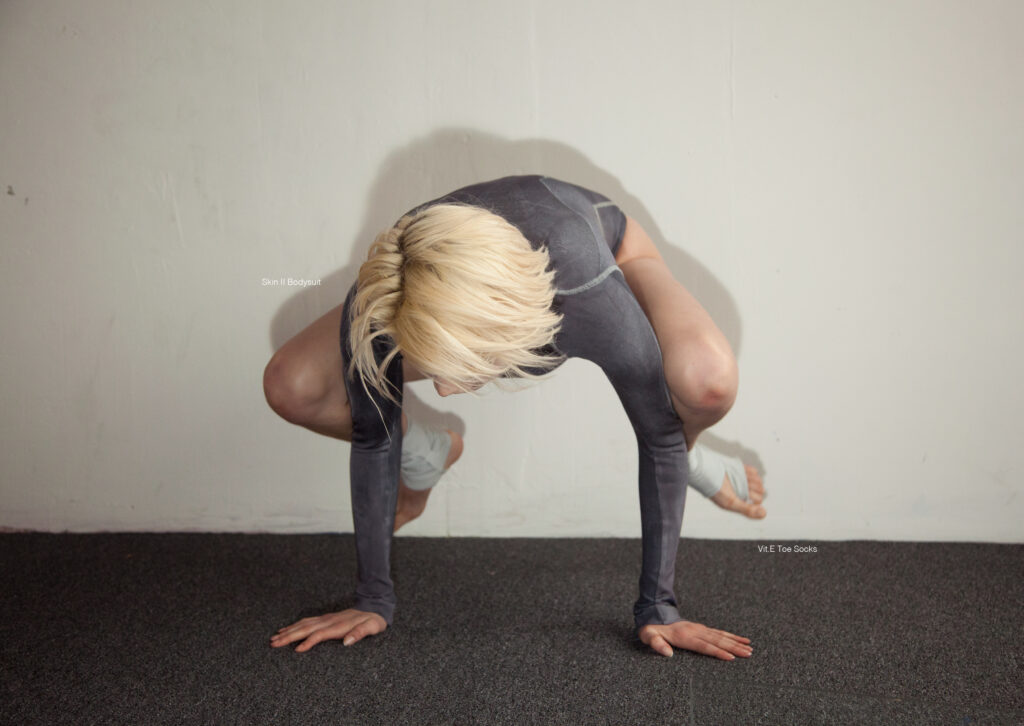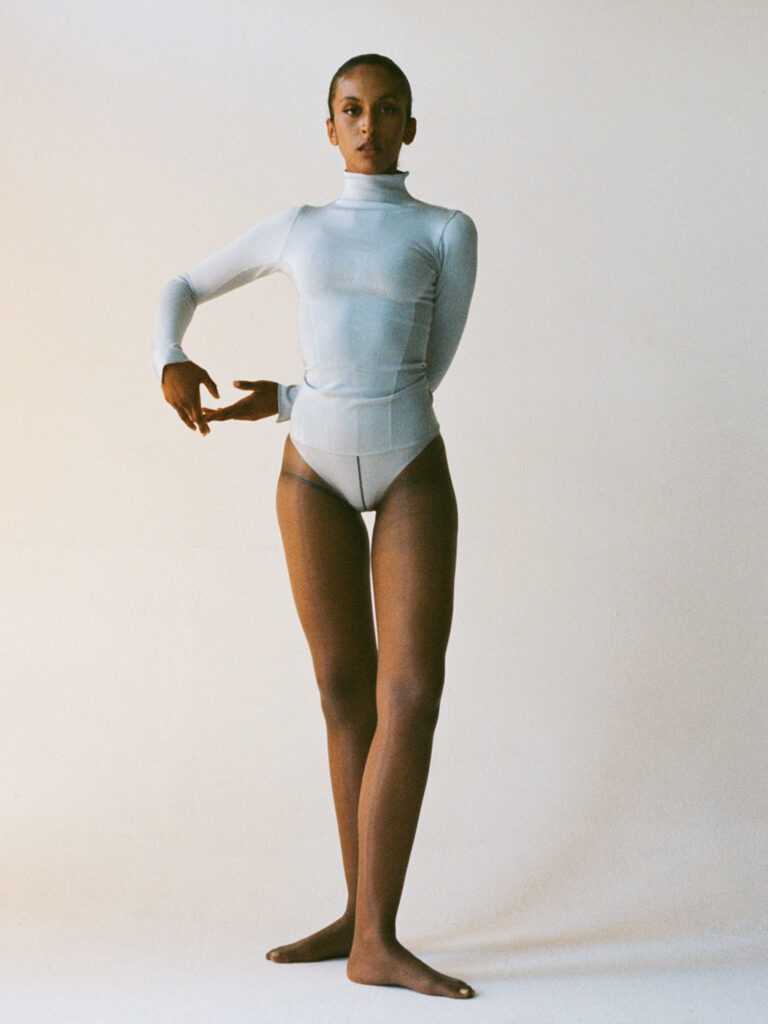Wei Ting Wong and Rosie Broadhead discuss the potentials of probiotic fashion

SKIN II Bodysuit and Vit.E Toe Socks from ‘SKIN II’
Rosie Broadhead is the founder of SKIN SERIES, a brand which fuses clothing design and bioscience. SKIN SERIES proposes that in the near future, your clothing could affect the internal workings of your body: what you put on in the morning could help neutralise the smell of body odour, or your underwear might relieve the pain of monthly cramps. Like the myriad supplements we can take each morning, the possibilities are endless.
Currently a researcher at Ghent University, Belgium, Rosie works in a lab with scientists to develop probiotic fabric. Used against the skin, they react with the body to improve the overall health of the wearer. This fabric is then designed into close-fitting garments: bodysuits, underwear, gloves and toe socks.
‘SKIN II’, the second instalment of SKIN SERIES includes an Algae Baselayer which can improve the immune system; the Plated Baselayer which helps with skin renewal; Magnesium Briefs which assist in regulating the nervous system, relieve muscle ache, tension, balance hormones and reduce anxiety; and Vit.E toe socks which encourage skin regeneration.
Three years ago, after a stint working in the luxury sportswear industry, Rosie started to question some of the standard practices within larger companies. “It always stood out to me that you would add chemicals to clothing in order to add function to a piece of fabric,” she explains, “[but] these chemicals were often very harsh and harmful to the skin and quite toxic for the environment to produce”.
This initial thought kick-started her passion for investigating more holistic, environmentally friendly processes. Eventually, she came across the work of microbiologist Dr. Chris Callewaert – or “Dr. Armpit” as he calls himself on Instagram. The foundation of his research is focused on colonising ‘good’ bacteria (or probiotics) onto the skin’s microbiome as a counterbalance for the ‘bad’ bacteria that causes body odour.
Rosie approached Dr Callewaert to propose that they adapt his research into clothing design. Since 2019, the two have been working together to develop fabrics through email and Whatsapp with Rosie in London completing her MA at Central Saint Martins and Dr Callewaert carrying on his research in Belgium. In early 2020, the duo received a grant from the University of Ghent to continue developing their project. Taking a leap, the designer took herself out of the studio and into the lab.

From ‘Skin Series I’ by Karl Felix
Wei Ting: Can you tell me a little about SKIN SERIES and how it came to be?
Rosie: The collection focuses on the body’s relationship with clothing as a permeable membrane. All the materials and ingredients we use are carefully considered. Also, on a very practical level, in order for these therapeutic fabrics to work at their best, they need to be in contact with the skin so often my designs are undergarments or fitted close to the body.
The construction and panelling system of each piece is designed with the ergonomics of the body in mind. Each fabric is knitted with a combination of yarns whose function is carefully considered. Working on the knitted construction of the fabric means I can manipulate where I think a certain yarn would work best on a particular part of the garment.
When I started designing my probiotic clothing in 2019, the bacteria I used were only activated with sweat or moisture. Therefore the probiotic technology was strategically placed in certain areas where you are more likely to sweat, such as down the back and under the arm. I mainly think about manipulating the synergy between the surface of the skin and the fabric. I’m trying to work towards a mindset where body and material are considered simultaneously.
WT: Why did you eventually to move to Ghent?
R: When I was doing my MA in London I would receive the results of my experiments from Chris and they would tell me what kind of materials and methods worked well and what didn’t but it was quite abstract information. For example, it would be apparent that the bacteria is sensitive to heat but we wouldn’t know exactly how much heat. It is quite an important factor for textile finishes.
Moving to Belgium and working directly with Chris in the lab has meant I could truly understand what was and wasn’t working with the development of the bacteria alongside textile methods. My knowhow of materials and textiles is something that a bioengineer doesn’t have so I come up with the questions and ways for application into design and sportswear. I’m also currently working with other third parties like dye manufacturers and textile finishing companies to see if all this can be produced to scale.
WT: How was it coming from a design background into a lab?
R: Initially, I didn’t even know how to make a petri dish. I also have another student I work with who’s doing an MA in Bioengineering and together we figure it all out. It’s quite fun. I know the project really well and can direct the research and she is more strategic and scientific in her approach.
It’s quite funny, some of the scientists at the lab are confused when I tell them I am a designer or when I don’t have the language for certain tests, like I would say “oh you know that DNA extracting thing?” instead of using the proper name and they would look at me like, “What are you doing here?”
Probably the most significant difference is that scientists are approaching very real problems that are not commonly thought as desirable subjects. In fashion you don’t really talk about disease or body fluids and they are seen as these unsexy things but as a scientist these are actually important parameters in your project.

Preview from Surface Tension, a digital exhibition which looks at the potential uses of materials on the human body
WT: What are the main ways your work differs to that of other designers?
R: For me the difference in time frame between research and design is one of the biggest challenges. Science and the fashion industry work on completely different timelines. To cultivate the bacteria needed for experiments it takes about a week, and then another week to see the results of an experiment and then another week to adjust and so on and so forth. It is not realistic that our research will fit into a seasonal fashion model.
I also like to think that science is not as black and white as it seems, there is an element of opinion, creativity and subjectivity that goes into the work. People can read into data from different points of view. It’s still a creative mindset but using different tools and parameters.
In fashion, I like that I offer a different perspective on materials, future materials and bio-design. Recently an organisation that works with Psoriasis got in contact with me to see if our research could apply to that other skin disease which is something that bacteria therapy could be a solution for. In a way, I am like a middleman between fashion and science and I enjoy that role.
WT: Are there other projects you’re working on at the moment that you would like to plug?
R: Currently, I am preparing a digital exhibition with artist Wilson Oryema called Surface Tension which is centred around realising the positive potential of materials on the body. The project launches next month and projects include an astronaut’s MCP glove designed for NASA, a face mask which utilises the anti-viral properties of seaweed, a CBD tampon and clothing which captures carbon. We feel now is the perfect opportunity to rethink materials and the environmental and cultural implications of what we wear and the materials which surround us.
*****